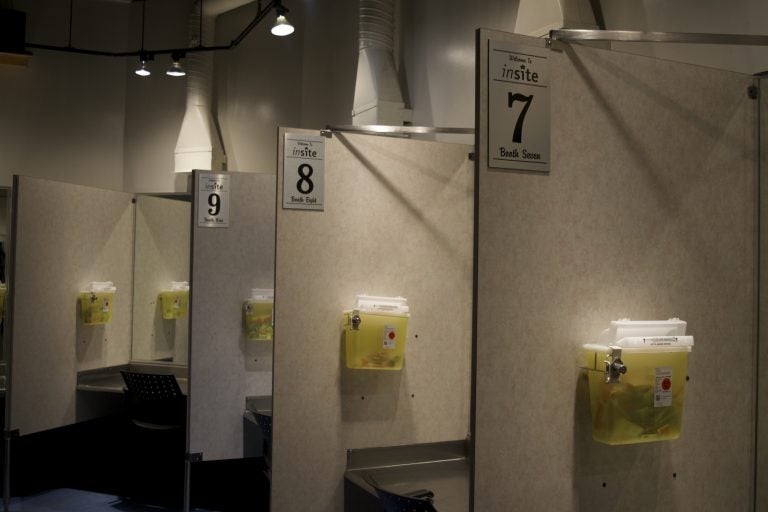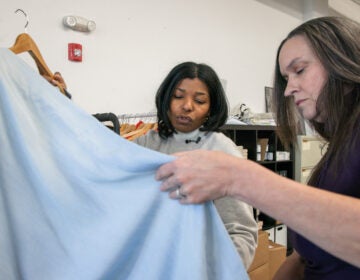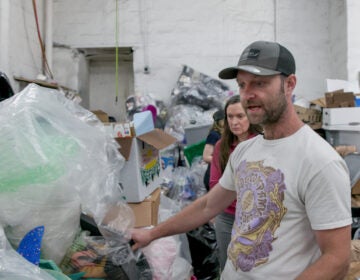Drexel survey shows wider neighborhood support for overdose prevention site
New research out of Drexel University found 90% of neighborhood residents responding to a survey approved of opening a supervised injection facility there.

Inside Insite, North America’s first public supervised injection facility, located in Vancouver. (Elana Gordon/WHYY)
A new study from Drexel University’s Dornsife School of Public Health found that 90% of Kensington residents who responded to an in-person survey supported an overdose-prevention site in their neighborhood. The nonprofit Safehouse has proposed to open such a facility where people could use drugs under medical supervision — also known as a supervised injection site — in Kensington.
The research, published in the Journal of Urban Health, draws from responses from 439 eligible respondents collected along a 1 ½-mile stretch of Kensington Avenue between Venango and Huntingdon Streets at different times of day between November and February. To be eligible, respondents had to be over 18 and live in the 19134 zip code.
Seventy-nine of the respondents were business owners in Kensington or employees there. Among that group, 63% favored an overdose-prevention site — the term the study’s designers used to describe the facility.
More than 100 such facilities exist worldwide, including in Canada, and studies have shown that they reduce overdose deaths, rates of disease related to injection drug use, and public drug consumption. No sanctioned site is operating in the United States, and Safehouse has been sued by federal prosecutors in an effort to block the planned Philadelphia facility.
The degree of support reflected in the Drexel survey is much higher than that seen in the results of two recent citywide phone polls, conducted by the Philadelphia Inquirer and Pew. They found, respectively, that only 22% and 50% of Philadelphia residents supported such a site.
Alexis Roth, a harm-reduction advocate and lead researcher of the Drexel study, attributed the substantially greater proportion of support to her study’s geographic focus.
“I think that people’s experience with drug-related social problems is exceptionally different in Kensington than it is in other parts of the city,” Roth said. “If you don’t know what it’s like to walk down the street with your children and your mother and your grandmother and see publicly discarded syringes or someone using, [you] can’t draw from that experience to think about what it would be like to have an intervention that has been shown to curb those specific effects.”
The Drexel survey’s results also seem to conflict with the vocal objections expressed at many community meetings on the subject of supervised injection sites. Kensington residents, led in part by members of the Harrowgate Civic Association, have voiced adamant opposition to the Safehouse plan to open such a facility, citing public safety as their main concern.
“If you open a safe injection site, they’re still going to buy from drug dealers who shoot our kids, and they’re still going to rob from us to support their habit,” said Shannon Farrell, president of the Harrowgate group. “It’s just going to keep the problem here.
Farrell said that she has collected thousands of signatures from residents in the Harrowgate, Kensington and Port Richmond neighborhoods opposing a supervised injection site, and that she did not believe the survey results could be credible or unbiased given Roth’s expressed support for supervised injection. She called the study “manufactured consent.”
But the results of the Drexel survey beg the question of whether the attitudes of an entire community have been represented at public meetings by the sentiments of a vocal few.
“That 90% of people who are supportive of an overdose-prevention site, I think their voices at community meetings are really important to hear, and we have not heard them as often as we’d like,” said Philadelphia Managing Director Brian Abernathy, who is leading the Mayor’s Resilience Project and has been in conversations with Kensington residents.
“I still don’t dismiss those public-safety concerns that have been raised — I think we still need to have an adequate public-safety plan in place. And I’m confident that we will by the time the site is ready to open,” Abernathy said.
The majority of respondents to the Drexel survey were stably housed people of color who have lived in Kensington for more than five years, and who had heard of overdose-prevention sites before they took the survey. The majority knew someone who had died of an overdose. Less than half reported current opioid use, and those who used opioids were more likely to support the sites than those who did not.
Among businesses owners and employees in the area, no one reported current opioid use, and business owners or employees of color were more likely to support such a site than their white counterparts.
The survey did include unstably housed residents, but researchers capped that group at 25% of all respondents. Roth said they decided to include people experiencing homelessness because they wanted a truly representative cross-section of Kensington residents.
“Being on the street doesn’t preclude you from having been on the streets of Kensington for a long time. Or having been stably housed and then as your life ebbs and flows you become unstably housed,” she said, adding that 80% of all survey respondents had lived in Kensington for over two years. “Policy makers and program implementers have an obligation to all of their constituents, so learning about the opinions of all of those constituents is important.”
Change of language
Previous research has found that using the term “overdose prevention site” in public-opinion polls yields 16% more support than does the term “safe consumption site.” Colleen Barry, who helped author that study, said choosing to use that language does not necessarily constitute a bias.
“It’s just a matter of framing,” Barry said.
David Dutwin, who designs survey research at Glen Mills-based market-research firm SSRS and is a former president of the American Association for Public Opinion Research, agreed that the language choice is a tricky one.
“Do you call someone a progressive or a liberal?” Dutwin said. “They both have different rhetorical implications nowadays.” He recommended using the most widely used term.
In Philadelphia, the terminology has changed throughout the course of the multiyear debate over such a facility — for example, from comprehensive user-engagement site to supervised injection site. In New Jersey, where legislation was introduced earlier this year proposing the sites, they are referred to as overdose prevention centers.
Barry cautioned that surveys can yield higher levels of support if they do what she called “combined messaging” — inserting endorsements of the intervention at the same time as attempting to gauge public opinion.
Before being asked their opinions on an overdose-prevention site, residents in Kensington were read a statement that went over the facts of what such a site would do, which included some of the evidence-based benefits that such facilities have been shown to have elsewhere.
Barry said that, after a quick read, she wouldn’t call that statement a combined message.
“I think it’s unlikely that that level of language would be driving a 90% support level,” she said.
Farrell, of the Harrowgate Civic Association, said she resented the notion that a lack of support was simply due to a lack of education on the issue.
“We understand it 100%, and we oppose it 100%,” she said.
For his part, Abernathy said he thought the survey results were likely surprising not because they were somehow misrepresentative, but because they captured the opinions of a group not often heard in public meetings.
“These meetings are at night — there are kids to take care of. We need to do a better job of engaging a broader swath of community than we have,” he said.
He added that it was still incumbent on the city and on Safehouse representatives to work with the entire community — especially those opposed to the site.
—
This article has been updated to clarify where the survey was conducted.
WHYY is your source for fact-based, in-depth journalism and information. As a nonprofit organization, we rely on financial support from readers like you. Please give today.





